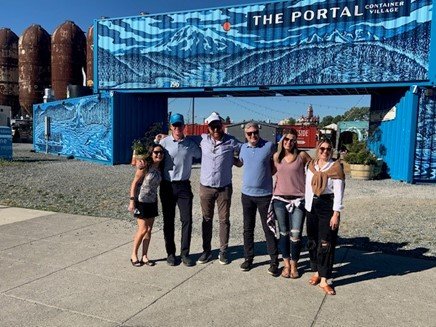Port of Bellingham Shows off All a Port Can Do for its Community
By: Eric ffitch, Executive Director
Last week, the WPPA staff ventured to Bellingham as a group, looking for sun, saltwater, and a port town to host our first staff retreat — where we gathered to discuss organizational goals, strategic planning, and more. We were welcomed warmly by the folks at the Port of Bellingham and accommodated in style by their tenants at the Hotel Bellwether. Sitting amidst a bustling bunch of happy folks on Thursday night at The Portal – the port’s container village alongside its iconic pump track – it was easy to see how the Port of Bellingham serves its community. The Port generates revenue through conventional and creative approaches and reinvests that revenue into facilities and projects that promote public access to the waterfront and to public resources in general.
From managing marinas to marine terminals, some of the Port of Bellingham’s operations are as classic as Washington ports get. Across two marinas – one up north, at Blaine Harbor, the other right downtown at Squalicum Harbor adjacent from downtown– the port is home to more than 2,000 vessel moorages. Commercial fishing vessels that troll the Salish Sea sit next to sailing boats and small pleasure craft, as recreation and commerce coexist at this port, as they do at so many of our members ports. Serving this maritime hub is an ecosystem of maritime businesses like Bellingham Cold Storage, the largest portside cold storage facility on the West Coast, which has been operating here since 1946.
As our tour continued south along the waterfront, the themes of public access and environmental stewardship echoed across more Bellingham projects. A major environmental cleanup at what was once a Georgia Pacific wastewater lagoon will utilize state Model Toxics Control Act (MTCA) money to return the site to productive use. Future work at that site could include the expansion of marine trades infrastructure to support the thriving working waterfront at Squalicum Harbor. From there, we saw multiple busy public parks that have been developed by the Port of Bellingham, culminating in what will soon be Bellingham’s largest public park: the Salish Landing Park, a partnership with the City of Bellingham that also relies on state cleanup funds.
Our tour ended with a perspective on the dual role of ports, with one foot in the maritime world and one foot firmly in aviation. The Bellingham International Airport was humming with activity when we walked through the sliding doors, but there was no line for security screening! At this efficient facility, the drop in demand attributed to COVID-19 has been reversed by new direct flights on Southwest Airlines to Las Vegas, Oakland, and most recently, Denver. Now passenger counts are approaching pre-pandemic levels, and the Port is exploring a separate International Arrivals area that would allow it to attract still more new routes to popular warm weather destinations south of the border.
In all, a sun-dripped tour covered an impressive breadth of operations, and left staff wanting more information and more time in this beautiful port town. We are grateful to the Port for their hospitality and will be back in Bellingham before too long!

